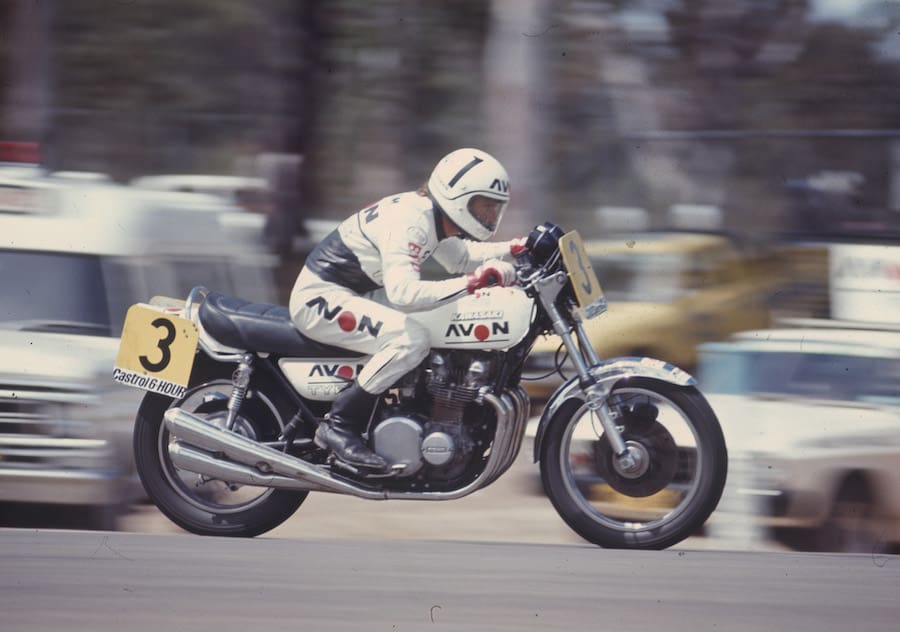Lindsay Walker – peerless presentation proved a winner
At 26 years old and somewhat at a loose end, Lindsay Walker was offered the opportunity to flog a few Avon tyres. After a few years peddling life-insurance policies, it marked the beginning of a new life in the tyre trade.
His sales skills quickly led to his appointment as the Avon agent for Sydney – just as the UK-based manufacturer axed all exports. Walker was soon London-bound, and he managed to keep a small supply of rubber headed Down Under.
When Avon later resumed exports, Walker took on responsibility for the full product range. This included Avon’s inflatable boats, one of which inveterate adventurer Hans Tholstrup used to transport his Mini Moke across the treacherous Bass Strait on his odyssey to Cape York. Walker carried the fuel in a second inflatable and later revealed that the refuels “made the crossing memorable, to say the least.”
By the mid-1970s, Avon enjoyed a healthy slice of the motorcycle tyre market and Walker witnessed a boost in sales after the Avon Road Runner-shod Ken Blake/Len Atlee Kawasaki Z1 won the 1974 Castrol Six Hour. Never was the axiom ‘win on Sunday, sell on Monday’ better demonstrated.
At the time, Metzler had introduced its C7 racing tyre, then coaxed dual Six Hour champion Brian Hindle from retirement, pairing him with Isle of Man TT production champ Helmut Dahne on a new BMW R90S that would need only two fuel stops to complete the 1976 Six Hour. The combination appeared indomitable.
But Walker had other ideas, and the newly formed Team Avon looked like winners from the moment they entered the paddock. Up went the large white marquee, out came the tables and chairs, and in came the caterers. All followed by the invited VIPs to support riders Jim Budd and Roger Heyes – both attired in white leathers to match the livery of the immaculately prepared Kawasaki Z900.
On race day, Budd used the Z900 to great effect, and after 77 minutes he was in for a refuel. And no one was more surprised than the BMW contingent when, after being stationary for just 6.5 seconds, Heyes blasted back out onto the track.
The team’s secret was the Swirl-Filler, an innovative device fitted to the mandatory 20-litre fuel container that cut refuelling times by half. BMW’s advantage was nullified, but the battle was far from over.

Aware of past scoring discrepancies, Walker had taken precautions: “We had our own team of lap scorers to count every lap of the top 10 competitors. It proved a masterstroke, as the officials missed one of our laps when we pitted. My wife, Hinke – a formidable woman – was despatched to the Control Tower, where it took a couple of hours to get the lap credited, putting us back in the lead.”
As Team Avon’s final refuel approached, there were accusations that the rear Avon Road Runner was way past its use-by date and chief scrutineer Chris Peckham was asked to investigate. But another super-quick refuel and rider change saved the day. Heyes was back on track before Peckham could sprint the length of pit lane.
Come 1978 and it was evident that faster speeds on the tight and abrasive Amaroo Park circuit would increase tyre wear.
“I figured everyone would be marginal on tyres,” Walker recalls. “I decided on a mid-race tyre change, making the shaft-drive Yamaha XS1100 a race-winning proposition.
“We practiced changing the rear wheel every night for a month and when we pulled it off – unannounced, in little more time than a normal refuel – it devastated the competition. I was so confident we’d win I’d already paid the ABC to compile a 30-minute clip of the event.”
After selling the Avon franchise, Walker built a highly successful computer business.
In retirement, you’re just as likely to find him on Sydney Harbour – with one or more of his 10 grandchildren – as you are sighting him on his immaculate Velocette Thruxton.
Peter Whitaker
